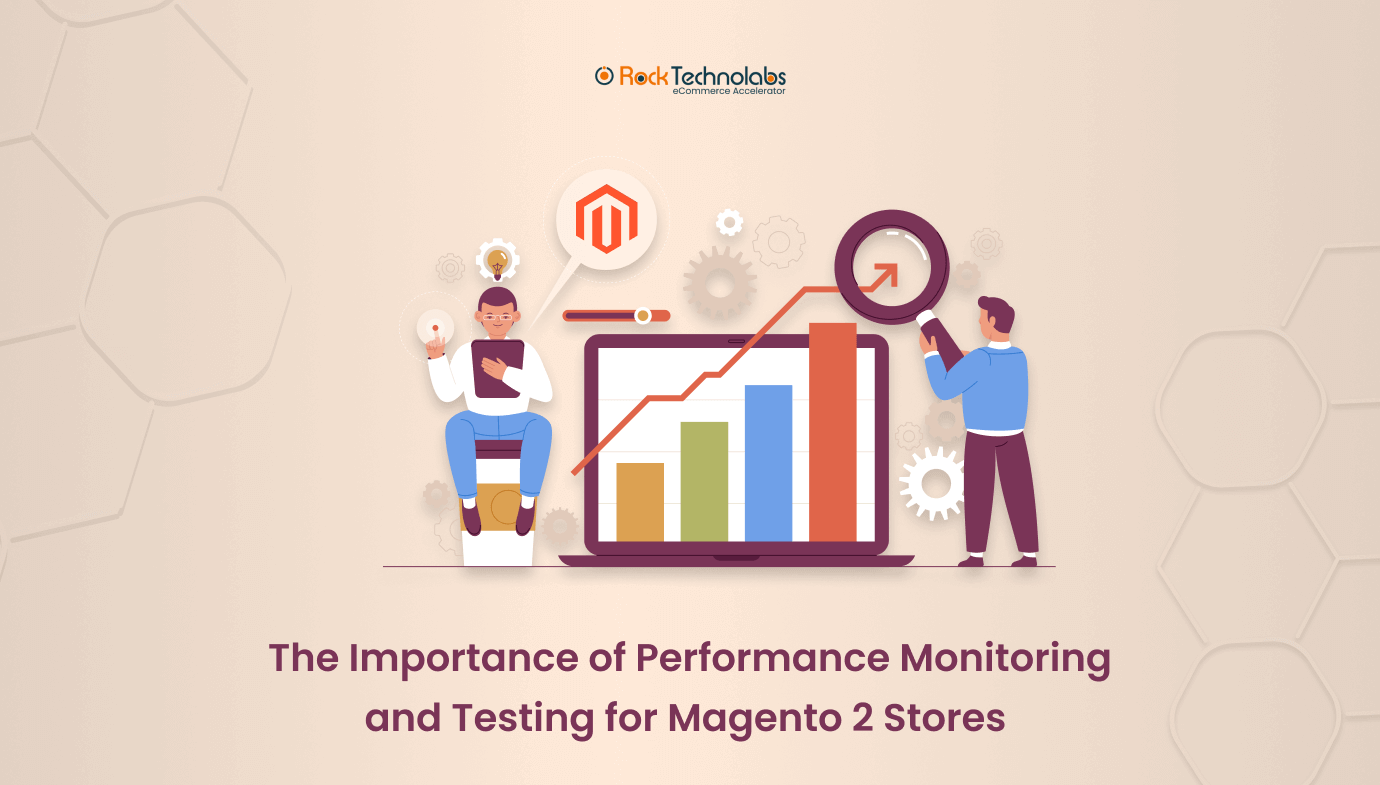Revolutionize Your E-commerce Success: The Importance of Performance Monitoring and Testing for Magento 2 Stores

Magento remains a top choice for businesses constructing high-performing eCommerce websites. With its diverse features, the platform is well-suited for online businesses in the digitized landscape of 2024.
Despite the fact that Magento is such a robust platform, we have to keep note that the modern consumer is characterized by impatience, which is why the slow page load times rank as the second most irritating aspect of online shopping for digital consumers. Consequently, if your Magento website exhibits extended loading times, poor navigation, or experiences layout instability, your visitors will probably become frustrated and seek alternatives.
This obviously means poor performance that plays a pivotal role in search engine rankings as well. Failure to meet performance standards may also result in penalties from Google, which makes it a necessity to reach out to a Magento upgrade service provider and opt for new technologies like Hyva theme development or upgradation.
However, fully leveraging all Magento features and doing constant performance monitoring and testing of your Magento store can be challenging due to its deviation from conventional eCommerce platforms, for which you can again go for Magento support services offered by experienced Magento developers.
But to ease your headache, in this blog, we are going to explain what exactly Magento 2 performance monitoring and testing entails and why it is a vital component for maintaining an efficient eCommerce website.
What Is Website Performance Optimization?
The speed at which website content loads and appears in a web browser, along with its responsiveness to user interaction, defines web performance. The responsiveness and loading speed of your website constitute the measurement of website performance while providing valuable insights to facilitate the optimization of your site for maximum speed and user-friendliness.
Sites with poor performance exhibit slow display and responsiveness to input, leading to increased rates of site abandonment. At its most severe, subpar performance can render content entirely inaccessible, so an ideal objective for web performance is to have users seamlessly experience it without consciously noticing any delays.
Although an individual’s perception of site performance is subjective, metrics can be employed to quantify loading and rendering. While good performance might go unnoticed by the majority of site visitors, a sluggish site is immediately recognizable to most. This is why we prioritize the importance of website performance optimization.
To resolve the issues, Magento developers or Magento support service providers practice Website Performance Optimization (WPO), which involves enhancing your website’s performance using various techniques, including image optimization, minimizing 301 redirects, incorporating a CDN, and implementing browser and server caching.
What Makes Magento Website Performance Crucial?
The health of your website is directly reflected in its performance. When users land on your site, the initial thing they notice is how quickly it loads.
Think of this initial interaction as the entrance of a physical clothing store. If the doors are excessively heavy and customers struggle to open them, they’ll likely seek the shop of your competitor. The smoother the entry process, the more inclined customers are to stay—a principle that applies equally to your website.
Optimizing website performance, monitoring and testing it significantly influences customer experience and the digital journey. A well-performing website can lead to:
- Increased website conversions and sales
- Enhanced visitor retention
- Lower bounce rates
- Prioritization of search engine optimization
Internal vs External Monitoring of Magento Website
Website performance monitoring can be categorized into two main types: Internal Monitoring and External Monitoring.
Internal Monitoring, often considered a safety net, involves tracking various web resource parameters such as server memory, CPU usage, network, and disk storage. It is essential for identifying issues like low available memory and monitoring server network traffic.
On the other hand, external Monitoring focuses on assessing the website’s performance beyond the company’s firewall, including customer experiences. This type of Monitoring aims to enhance the end-user experience that requires the assistance of a Magento upgrade service provider and involves the following components:
- Web Stress Tester: To assess how the website performs under sudden high traffic, web stress testing puts a predefined load on the site. This helps understand resource requirements during peak traffic, ensuring stability during events like flash sales.
- API Monitoring: JMeter, BlazeMeter, and others, an open-source testing software, is employed for API monitoring that encompasses testing load, function, regression, and performance to assess both static and dynamic resources.
- Uptime Monitoring: This critical aspect of Magento monitoring involves regular checks on the availability of the website, which includes response time that is evaluated from different locations, ensuring that potential revenue is not lost due to downtime.
- Synthetic Transaction Monitoring: This type of Magento monitoring checks the functionality of web pages by simulating user actions such as visiting the website, registering, browsing, and making purchases. Also, automated tests replicate user actions, identifying errors to ensure the website is available 24/7.
- Real User Monitoring: This Magento monitoring type gathers data from actual users, providing insights into website performance. It analyzes user interactions, identifies potential issues, and collects data on page views, time spent, and load time.
Optimal Strategies for Enhancing Magento 2 Performance
1. Enhance Database Efficiency
Despite Magento’s substantial market share and commendable performance benchmarks, there is room for improvement in its database. One prevalent factor contributing to this is the space consumed by logs. Eliminating these logs significantly enhances database performance by reducing lag in process execution.
Note: It is advisable to create a recent backup before implementing any new changes to the database.
Additionally, Magento generates new log files automatically and frequently. Therefore, removing old logs should not pose any issues. To configure log retention time, you must talk to the Magento support service provider.
2. Implement Advanced JavaScript Bundling
While JavaScript Bundling minimizes server requests per page, it loads all the bundles for each page upon request, leading to inefficiencies. The browser’s caching of bundles enhances performance, yet there’s an alternative to address this issue — advanced JS bundling.
Advanced JS bundling serves to optimize performance by reducing the number of HTTP requests to the server and diminishing the size of JS files, similar to regular JS bundling. The key distinction lies in its ability to avoid loading all bundles for every page requested by a browser.
Considering that each page has specific required dependencies, advanced JS bundling ensures that only the necessary bundles are loaded to fulfill the requirements of each page, minimizing unnecessary downloads.
3. Upgrade Your Magento Version:
Upgrading to the latest Magento version brings new features, enhancements, and bug fixes, optimizing the overall user experience. To boost and refine your Magento website’s performance, it’s crucial to transition to the most recent version of Magento. Particularly if you’re currently using Magento 1, consider migrating to Magento 2, as it offers numerous features that help you align with market trends and customer demands while providing significantly enhanced security.
If you’re uncertain about where to begin the upgrade process for your eCommerce store, seek guidance from Rock Technolabs expert and certified Magento developers. They can offer a tailored migration plan based on your specific requirements, ensuring a swift process, even for intricate configurations and extensive customizations, without stretching over weeks or months.
4. Activate GZIP Compression for Faster Magento Speed
Enabling GZIP compression proves to be an effective strategy for accelerating content loading and enhancing the overall speed of your Magento store.
In the context of Magento 2, where the server juggles numerous requests concurrently, configuring GZIP compression emerges as a fitting solution to handle CPU load times efficiently and minimize bandwidth usage.
The primary advantage lies in the reduction of download times for website page files and style sheets, ultimately contributing to a decrease in your website’s overall load time. This serves as a valuable tip for optimizing speed.
Wrapping Up
Ensuring optimal performance and thorough testing for your Magento 2 store is crucial for maintaining an online store that is both fast and efficient and satisfies your customers’ expectations.
By prioritizing essential metrics and keeping track of performing routine audits of your Magneto store performance, you can guarantee the competitiveness of your store and provide an exceptional user experience while generating higher revenue.
If you think that your site has many technical issues or need upgradation or Hyva theme development, Rock Technolabs (one of the best Magento support service providers)is here to assist you – +91 79 4004 8843





